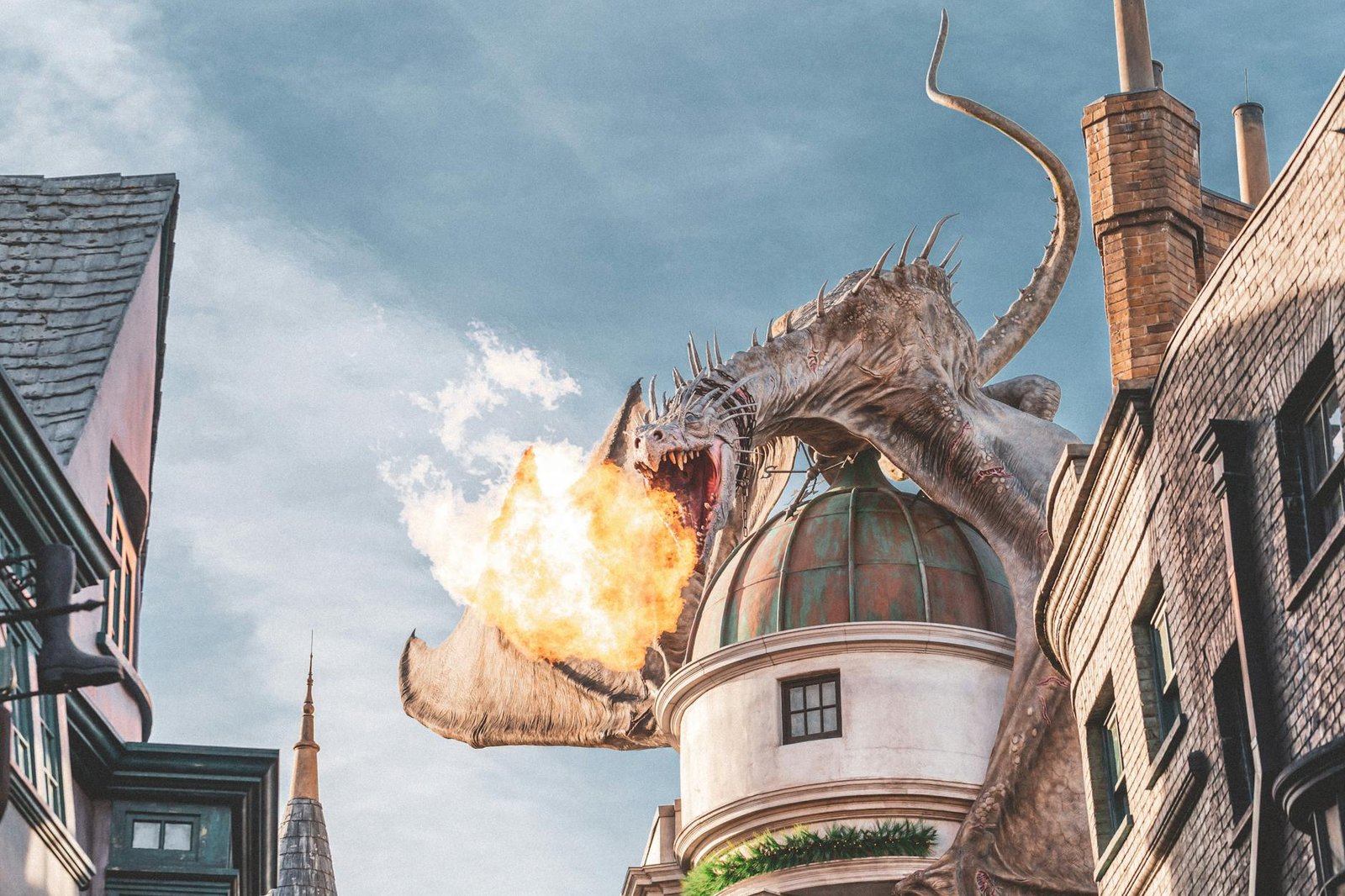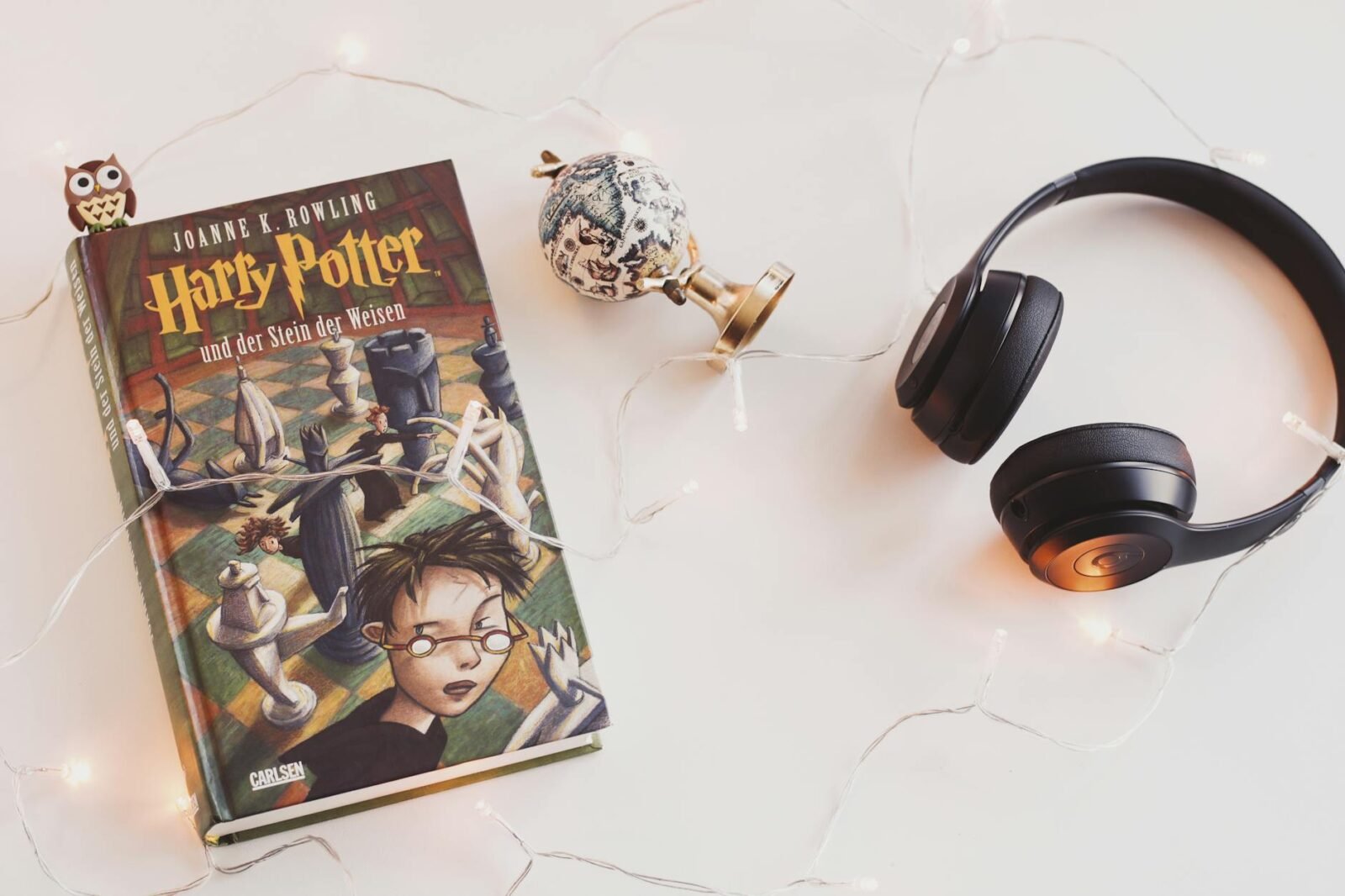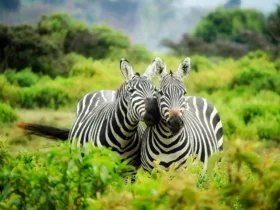Last Updated on May 25, 2024 by Daniele Lima
Learn more about the Harry Potter series and its magical characters
The Harry Potter saga, written by renowned British author JK Rowling, won millions of fans around the world and became a pop culture phenomenon.
With seven books and eight films, the story of the young wizard and his friends has enchanted generations and created an unforgettable magical universe.
In addition to the engaging plot, there is also a set of curiosities surrounding the creation and development of Harry Potter. In this article, we will present 10 fascinating facts about the saga, revealing surprising details behind the pages and screens.
Table of Contents
1 – The inspiration behind the name Harry Potter
The inspiration behind the name “Harry Potter” is fascinating and involves a combination of author JK Rowling’s personal and creative influences. The series’ main character, Harry Potter, is a young wizard destined to play a vital role in the fight against the powerful dark wizard, Lord Voldemort. JK Rowling has stated that the idea for the name “Harry” simply popped into her mind during a train journey from Manchester to London in 1990. However, she also seemed to have always liked the name “Harry” and thought it was a good name. welcoming and friendly.
As for the surname “Potter”, JK Rowling revealed that she was inspired by a neighborhood she lived in as a child. She grew up near a house where a family called Potter lived, and the author was captivated by the name. Furthermore, “Potter” is a very common surname in England, which adds a touch of British dependence to the story.
The choice of the name “Harry Potter” can also be seen as an allusion to the English literature tradition of stories about courageous and fearless orphans, such as Charles Dickens’ Oliver Twist. Rowling wanted to create a character who was a gifted hero, coming from humble beginnings but destined for great things.
Overall, the inspiration behind the name “Harry Potter” involves a combination of intuition, personal experiences, and literary references. This name has become iconic and symbolic of the beloved book and film series, capturing the imagination of millions of fans around the world.
2 – The first rejected manuscript

At the time of my training, in September 2021, there was no information about the existence of the first rejected Harry Potter manuscript. Available records suggest that JK Rowling, author of the series, was eager to find a publisher available to publish the first book, titled “Harry Potter and the Philosopher’s Stone.” However, once the manuscript was accepted by publisher Bloomsbury in 1997, the Harry Potter series became a global phenomenon, gaining a dedicated fan base across the world.
It’s important to point out that stories about an initially rejected manuscript may just be rumors or speculations that have died down over the years. There is no official confirmation that there is a first Harry Potter manuscript that was rejected before the first book was published.
JK Rowling tried in interviews that she left several rejections before finding a publisher willing to release her work, but did not specifically refer to a previously rejected manuscript. It is common for many prominent authors to have faced rejection before achieving success.
The case of Harry stands out for its widespread acceptance after its initial publication, leading to a series of successful books, an affinity for film, and a significant influence on popular culture. The Harry Potter saga continues to be loved by fans of all ages around the world.
It is common for many prominent authors to have faced rejection before achieving success. The case of Potter stands out for its widespread acceptance after its initial publication, leading to a series of successful books, an affinity for film, and a significant influence on popular culture.
The Harry Potter saga continues to be loved by fans of all ages around the world. It is common for many prominent authors to have faced rejection before achieving success. The case of Potter stands out for its widespread acceptance after its initial publication, leading to a series of successful books, an affinity for film, and a significant influence on popular culture. The Harry Potter saga continues to be loved by fans of all ages around the world.
3 – A talking wizard
Professor Severus Snape is a fictional character in the “Harry Potter” book series written by JK Rowling. He is one of the most complex and intriguing characters in history, playing a vital role in the overall plot. Snape is initially introduced as a Potions professor at Hogwarts School of Witchcraft and Wizardry.
He is described as a man of neutral and austere appearance, with black hair and black, penetrating eyes. His personality is generally described as cold, sarcastic, and intimidating, which makes him feared and hated by many students. However, throughout the series, it becomes apparent that there is much more to Snape than his appearance and hostile attitude suggest.
We discover that he was one of Potter’s childhood friends, fathered his arch-rival, Draco Malfoy, and was also deeply in love with Harry’s mother, Lily Evans.
Snape’s true loyalty is one of the most defining aspects of his character. Initially, he appears to be on the side of the Dark Lord Voldemort and serves as a double spy for the Order of the Phoenix, an organization dedicated to fighting the forces of darkness. He becomes a Defense Against the Arts professor of darkness at Hogwarts after Alastor Moody’s retirement.
The most impactful revelation about Snape occurs in the sixth book, “Harry Potter and the Half-Blood Prince” when we discover that he has been an important member of the Order of the Phoenix since the first war against Voldemort. Snape made a vow to protect Potter at the request of Dumbledore, the headmaster of Hogwarts. His devotion to this mission is repeated over and over again, as Snape has to keep his dual loyalties secret, faces suspicion, and resists the attempt to fully return to the dark side in an even more complicated position.
Actor Alan Rickman was the only cast member who knew about his character’s fate from the beginning. Rowling reveals plot secrets to Rickman before releasing the books, allowing him to play his role with greater depth and knowledge.
4 – Harry Potter in other languages:

The Harry Potter books have been translated into more than eighty languages, making them a global phenomenon. However, some of the translations had to adapt to linguistic and cultural peculiarities. For example, in the Brazilian version, platform 9 3⁄4, where Hogwarts students board the train, was translated as platform 9 3⁄4.
French (Harry Potter and the Philosopher’s Stone):
The Harry Potter books were translated into French by Jean-François Ménard. The series is very famous in France, and the films have also been dubbed into French. The French translation retained the authentic title of the first book, “Harry Potter and the Philosopher’s Stone”, as “Harry Potter à l’école des sorciers”. The magic words, spells, and other terms have been adapted into French, maintaining the spirit of the authentic story
Spanish (Harry Potter and the Philosopher’s Stone): The Harry Potter books were translated into Spanish by Alicia Dellepiane Rawson. In Spain and many Hispanic countries, the series is known as the “philosopher’s stone”, directly translating the title of the first book. As in other translations, the names of the characters, spells, and other elements were adapted into Spanish.
Germany (Harry Potter and the Philosopher’s Stone): In Germany, the Harry Potter series was translated by Klaus Fritz. The title of the first book in German is “Harry Potter und der Stein der Weisen“, which means “Harry Potter and the Philosopher’s Stone”. The German translation also adapted names and terminology for the language, providing an immersive experience for German readers.
Italian (Harry Potter and the Philosopher’s Stone): The Italian translation of the Harry Potter books was done by Marina Astrologer. In Italy, the first book is known as “Harry Potter and Los Angeles Philosophical Pietra”. The translation maintained the essence of the authentic story, adapting the characters’ names and magical elements into Italian.
5 – Harry Potter Characters Names:
Those who have followed the series since the beginning know that some actors started recording at a very young age, as you can see below:
Daniel Radcliffe (Harry Potter): Daniel was born on July 23, 1989. He was just twenty years old when he was cast as the protagonist of the Harry Potter film series in 2000.
Emma Watson (Hermione Granger): Emma was born on April 15, 1990. Like Daniel Radcliffe, she was eleven years old when she was chosen to play Hermione Granger.
Rupert Grint (Ron Weasley): Rupert was born on August 24, 1988. He was the oldest of the three main actors, being nine years old when he was cast as Ron Weasley.
Tom Felton (Draco Malfoy): Tom was born on September 22, 1987. He was thirteen years old when he began playing Draco Malfoy in the Harry Potter films.
Bonnie Wright (Gina Weasley): Bonnie was born on February 17, 1991. She was 10 years old when she debuted as Ginny Weasley in “Harry Potter and the Philosopher’s Stone.”
Matthew Lewis (Neville Longbottom): Matthew was born on June 27, 1989. He was eleven years old when he was cast as Neville Longbottom.
Evanna Lynch (Luna Lovegood): Evanna was born in September 1991. She was 14 years old when she first played Luna Lovegood in “Harry Potter and the Order of the Phoenix.”
6 – The secret of the script
Over the years, the production process for each Harry film has been carefully planned and executed. The creative core involved a select group of talented individuals, including the director, writers, producers, and production designers. They worked closely with J.K. Rowling to ensure the essence of the books was faithfully captured on screen.
In order to keep the plot and plot details secret, security measures were implemented in all aspects of the production. The scripts were treated with great confidentiality and only authorized people had access to them. Actors and production staff were required to sign strict non-disclosure agreements, which included significant penalties if confidential information was leaked.
Additionally, during filming, restricted access areas were established to prevent unauthorized access. Security cameras were installed and cell phones and personal electronic devices were generally prohibited on filming units. All of this was done to ensure that the story’s surprises and twists were not revealed before the films were released.
These security and secrecy measures also extended to advertising and marketing and film distribution partners. Trailers and promotional materials were carefully selected to not reveal too much of the plot, keeping suspense and fan interest high.
The result of this dedication to confidentiality and secrecy was the creation of a magical cinematic experience for Harry Potter fans around the world. The surprises, exciting moments, and stunning visual effects have been preserved until the release of each film, allowing viewers to immerse themselves in the world of Hogwarts and enjoy the journey of Harry Potter and his friends as if they were experiencing the magic for the first time.
Therefore, the Harry Potter production team meticulously valued and kept the script secret, providing an exceptional cinematic experience for fans while keeping the magic and emotion intact.
7 – How many Harry Potter books:
The Harry Potter books became longer as the story progressed. More than seven books that JK According to Rowling, the total number of pages varies according to editions and translations into different languages. However, the English edition of the original series has a total of approximately 4,195 pages. Here is a breakdown of the number of pages in an English book:
1 – “Harry Potter and the Philosopher’s Stone” – approximately 223 pages.
2 – “Harry Potter and the Chamber of Secrets” – close to 251 pages.
3 – “Harry Potter and the Prisoner of Azkaban” – close to 317 pages.
4 – “Harry Potter and the Goblet of Fire” –approximately 636 pages.
5 – “Harry Potter and the Order of the Phoenix” – approximately 766 pages.
6 – “Harry Potter and the Half-Blood Prince” – close to 607 pages.
7 – “Harry Potter and the Deathly Hallows” – approximately 607 pages.
In addition to the total number of pages, it is worth mentioning that the length of the Harry Potter Books varies greatly.
Early books in the series, like Philosopher’s Stone and Chamber of Secrets, are shorter and have fewer pages, while later books, like Order of the Phoenix and Deathly Hallows, are considerably longer, longer, and louder. This progression in book length reflects the maturation of the story and characters throughout the series.
As the plot progresses, JK Rowling introduces more complex elements and develops the plot in more detail, resulting in books with an increasing number of pages.
Additionally, it is worth noting that translations into other languages can also affect the number of pages.
8 – Characters inspired by real people:
Some Harry Potter characters are inspired by real people:
Severus Snape: Potions and Defense Against the Dark teacher, known for his dark and complex personality, is partially modeled after teacher JK Rowling at the school.
Minerva McGonagall: Enlightenment Professor and Head of Gryffindor was inspired by the real-life teacher JK Rowling considered a mentor.
Rita Skeeter: The gossipy witch reporter known for her sensational and manipulative stories was inspired by the real-life reporters JK Rowling faced throughout her career.
Neville Longbottom: Although Neville is a fictional creation, JK Rowling mentioned that he was inspired by brave children who faced challenges and difficulties in childhood.
Luna Lovegood: An eccentric and dreamy student of Ravenclaw House, known for her unique worldview, she was inspired by some of the same people as JK Rowling felt throughout her life.
Final Conclusion:
These are just a few examples of Harry Potter characters that have connections to real people, JK Rowling. The author drew inspiration from a variety of sources, combining elements of reality with his rich imagination to create likable and memorable characters.
The Harry Potter saga has conquered the world with its magic, memorable characters, and captivating story. Behind the pages of books and movie screens, there are countless fascinating topics that take us deeper into the world created by JK. Rowling.
From the inspiration behind Harry Potter’s name to the power of the fans, these fun facts reveal the richness and complexity of this beloved saga. Harry Potter has become an enduring cultural phenomenon, and its influence will be felt by future generations, who will find wonder and inspiration as they delve into this magical universe.
Harry Potter – FAQ:
When was Harry Potter born
Harry Potter was born on July 31, 1980, according to the timeline provided in the series. This date holds significance in the wizarding world and is celebrated by fans worldwide as Harry Potter’s birthday.
Why is Harry Potter so popular
Harry Potter’s popularity stems from its engaging plot, richly developed characters, and the magical universe created by J.K. Rowling. It resonates with readers of all ages, offering themes of friendship, courage, and the battle between good and evil, making it a beloved cultural phenomenon.
Why did Voldemort kill Harry Potter parents
Voldemort killed Harry Potter’s parents, James and Lily Potter, because he saw Harry as a threat to his quest for power. Prophecies foretold that a child born at the end of July, like Harry, would have the power to defeat him. Voldemort targeted the Potters to eliminate this potential threat to his reign of terror.
Why did Harry Potter drop the resurrection stone
Harry Potter dropped the resurrection stone into the Forbidden Forest as a symbolic gesture of acceptance and closure. He realized that using the stone to bring back loved ones from the dead would only trap them in a state of limbo and prevent him from moving forward. Letting go of the stone symbolized Harry’s acceptance of mortality and his readiness to embrace life without clinging to the past.











Leave a Reply